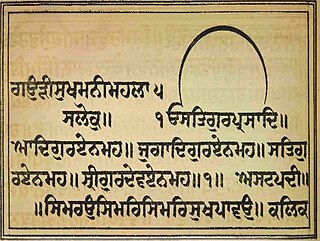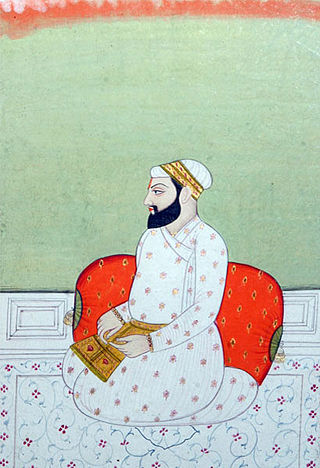
Sikhism, also known as Sikhi, is an Indian religion and philosophy in particular for the Sikh ethnoreligious group that originated in the Punjab region of India around the end of the 15th century CE. The Sikh scriptures are written in the Gurumukhi script particular to Sikhs. It is one of the most recently founded major religious groups and among the largest in the world, with about 25–30 million adherents.

The Guru Granth Sahib is the central holy religious scripture of Sikhism, regarded by Sikhs as the final, sovereign and eternal Guru following the lineage of the ten human gurus of the religion. The Adi Granth, its first rendition, was compiled by the fifth guru, Guru Arjan (1564–1606). Its compilation was completed on 29 August 1604 and first installed inside the Golden Temple in Amritsar on 1 September 1604. Baba Buddha was appointed the first Granthi of the Golden Temple. Shortly afterwards Guru Hargobind added Ramkali Ki Vaar. Later, Guru Gobind Singh, the tenth Sikh guru, added hymns of Guru Tegh Bahadur to the Adi Granth and affirmed the text as his successor. This second rendition became known as the Guru Granth Sahib and is also sometimes referred to as the Adi Granth.
The following outline is provides an overview of Sikhism, or Sikhi.

Sukhmani Sahib, known under the title of Gauri Sukhmani in the scripture, is usually translated to mean Prayer of Peace is a set of 192 padas present in the holy Guru Granth Sahib, the main scripture and living Guru of Sikhism from Ang 262 to Ang 296. This Gurbani text was written by the 5th Guru, Guru Arjan (1563–1606) at Amritsar in around 1602. Guru Arjan first recited the bani at Gurdwara Barth Sahib in the Gurdaspur district of Punjab, India.
In Sikhism, Nām Japō (Punjabi: ਨਾਮ ਜਪੋ, pronunciation: ), also known as Naam Japna or Naam Simran, is the remembrance of God or the Akal Purkh, the supreme formless power that is timeless and deathless, through the meditation or contemplation of the various Names of God, especially the chanting of the word "Waheguru" representing the formless being, the creator of all the forms, and the being omnipresent in all forms.
Jainism (/ˈdʒeɪnɪzəm/), traditionally known as Jain Dharma, is an ancient Indian religion. Jain dharma traces its spiritual ideas and history through a succession of twenty-four leaders or tirthankaras, with the first in current time cycle being Lord Rishabhanatha, whom the Jain tradition holds to have lived millions of years ago, the twenty-third tirthankara Parshvanatha whom historians date to 8th or 7th century BCE, and the 24th tirthankara, Mahāvīra around 500 BCE. Jains believe that Jainism is an eternal dharma with the tirthankaras guiding every cycle of the Jain cosmology.
In Sikhism, the Five Thieves, also called the five evils or the five vices, are the five major weaknesses of the human personality at variance with its spiritual essence, and are known as "thieves" because they steal a person's inherent common sense. These five thieves are kaam (lust), krodh (wrath), lobh (greed), moh (attachment) and ahankar.
Lobh is a word derived from the Sanskrit (लोभ), which translates in English to "greed"; it is a strong desire for worldly possessions and a constant focus on possessing material items, especially the urge to possess what rightfully belongs to others. It is one of the Five Evils of Sikhism that hinder one's spiritual progression. An individual suffering from the evil is known as a Lobhi.
Moh is a word in Punjabi and Sanskrit which describes attachment to worldly possessions or individuals. It is one of the five thieves within Sikh philosophy which hinder one's spiritual development.
Ahankar, commonly rendered as Hankaar or Hankār based upon its pronunciation in Punjabi, is a Gurmukhi word originating from the Sanskrit word Ahankāra which translates to mean "ego" or "excessive pride" due to one's possessions, material wealth, spirituality, beauty, talents, physical strength, intelligence, authoritative powers, charity work, amid others. It is one of the five thieves of Sikhism which hinder one's spiritual's progression.

The principal Sikh scripture is the Adi Granth, more commonly called the Guru Granth Sahib. The second most important scripture of the Sikhs is the Dasam Granth. Both of these consist of text which was written or authorised by the Sikh Gurus.
Haumai is the concept of self-centeredness (egoism) in Sikhism which hinder humanity's spiritual development and cultivation.

In Sikhism, God is conceived as the Oneness that permeates the entirety of creation and beyond. It abides within all of creation as symbolized by the symbol Ik Onkar. The One is indescribable yet knowable and perceivable to anyone who surrenders their egoism and meditates upon that Oneness. The Sikh gurus have described God in numerous ways in their hymns included in the Guru Granth Sahib, the holy scripture of Sikhism, but the oneness of formless God is consistently emphasized throughout.

In Sikh discipline, a Sikh is required by the Sikh Gurus to live a disciplined life by doing pure and righteous deeds and actions. The following are the list of activities that a Sikh should engages in:
The following list consists of concepts that are derived from both Sikh and Indian tradition. The main purpose of this list is to disambiguate multiple spellings, to make note of spellings no longer in use for these concepts, to define the concept in one or two lines, to make it easy for one to find and pin down specific concepts, and to provide a guide to unique concepts of Sikhism all in one place.

Guru Maneyo Granth refers to the historic statement of the 10th Sikh Guru, Guru Gobind Singh (1666–1708) shortly before his demise on affirming the sacred scripture Adi Granth as his successor, thereby terminating the line of human Gurus. Installed as the Guru Granth Sahib, it is now the central holy scripture of Sikhism, and the eternal living Guru of all Sikhs. It is central to Sikh worship as it is said to imbibe the one light of the creator manifested in the Ten Sikh Gurus‐one spirit in ten forms.

Sri Chand, also referred to as Baba Sri Chandra or Bhagwan Sri Chandra, was the founder of the Udasi sect of ascetic Sadhus. Sikh sources give his life the impressive dates of 8 September 1494 – 13 January 1629, which would have made him 134 years old upon his death.

Guru Arjan was the fifth of the ten total Sikh Gurus. He compiled the first official edition of the Sikh scripture called the Adi Granth, which later expanded into the Guru Granth Sahib. He is regarded as the first of the two Gurus martyred in the Sikh faith.

The Guru Granth Sahib, is the central religious text of Sikhism, considered by Sikhs to be the final sovereign Guru of the religion. It contains 1430 Angs, containing 5,894 hymns of 36 saint mystics which includes Sikh gurus, Bhagats, Bhatts and Gursikhs. It is notable among foundational religious scriptures for including hymns from writers of other religions, namely Hindus and Muslims. It also contains teachings of the Sikh gurus themselves.

Kaam is one of the five thieves in Sikhism, described as excessive lust or desire. A devout Sikh is expected to be in control of Kaam at all times.










